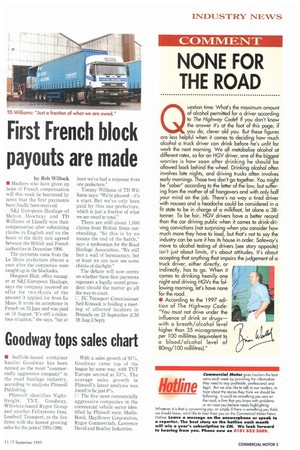NONE FOR THE ROAD
Page 7

If you've noticed an error in this article please click here to report it so we can fix it.
uestion time: What's the maximum amount of alcohol permitted for a driver according to The Highway Code? If you don't know the answer it's at the foot of this page; if you do, clever old you. But these figures are less helpful when it comes to deciding how much alcohol a truck driver can drink before he's unfit for work the next morning. We all metabolise alcohol at different rates, so for an HGV driver, one of the biggest worries is how soon after drinking he should be allowed back behind the wheel. Drinking alcohol often involves late nights, and driving trucks often involves early mornings. Those two don't go together. You might be "sober" according to the letter of the law, but suffering from the mother of all hangovers and with only half your mind on the job. There's no way a tired driver with nausea and a headache could be considered in a fit state to be in charge of a milkfloat, let alone a 38tanner. To be fair, HGV drivers have a better record than the car driving public when it comes to drink-driving convictions (not surprising when you consider how much more they have to lose), but that's not to say the industry can be sure it has its house in order. Safeway's move to alcohol testing of drivers (see story opposite) isn't just about limits, it's about attitudes. It's about accepting that anything that impairs the judgement of a truck driver, either directly, or indirectly, has to go. When it comes to drinking heavily one night and driving HGVs the following morning, let's have none for the road.
• According to the 1997 edition of The Highway Code: "You must not drive under the influence of drink or drugs— with a breath/alcohol level higher than 35 rnicrogrammes per 100 millilitres (equivalent to a blood/alcohol level of 80mg/100 millilitres)."


























































































































